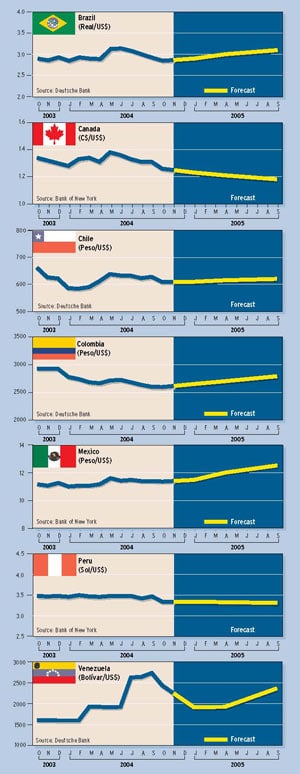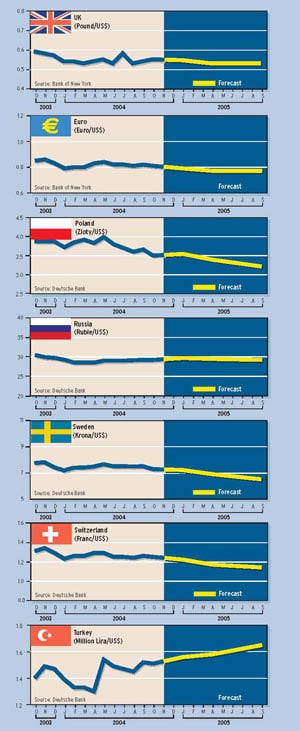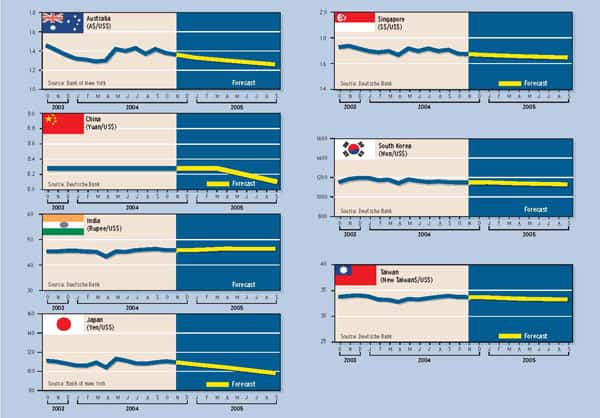FOREIGN EXCHANGE
 |
Weaker-than-expected US payroll data triggered a sell-off in the dollar last month, and analysts say the outlook for the greenback has deteriorated. The dollar slumped to the lower end of its months-long trading range against the euro and hit an 11-year low against its Canadian counterpart in early October. Market participants have begun to question Federal Reserve chairman Alan Greenspans assertion that the US economy has left the soft patch of last spring behind it, analysts say. The market is relying more on its own take on the economy, says David Gilmore, economist and partner at Essex, Connecticut-based Foreign Exchange Analytics. It believes that the soft patch is more like an extensive marsh, with the economy still knee-deep in muck and looking for the way out, he says. A prolonged soft spot would make it more difficult for the Fed to raise the federal funds rate to a neutral level of between 3% and 5% in 2005, Gilmore says. The rise in the price of oil is changing everything, he says. Indeed, if Greenspan and the Fed were right about oil as the catalyst for the slow patch in the US economy this spring, when crude was $40 a barrel, what kind of patch does $53 a barrel generate? he asks. index of US consuconfidence fell in September to the level since May, amand falling stock pto show some conimprovement, consumer confidence may vecontinue falling, ait consumer demaeconomic growth prospects, says MiWoolfolk, senior currency strategist at Bank New York. soft patch is transitconfidence and speprices and rising inrates, he says. Manufacturing jobs fell for the thstraight month, heHowever, there wahiring in financial and government. Higher energy have undoubtedly undermined businsentiment and promore-cautious approach toward new hiring,Woolfolk says. a potential of the US and global economies, the dollar continues to take its knocks from long-term concerns about funding the deteriorating US current-account deficit, which reached $166 billion, or 5.75% of gross domestic product, in the Bankim Chadha, global head of macro FX research at Deutsche Bank, says Fed officials are increasingly drawing attention to the view that an inevitable adjustment of the current-account deficit will entail significant dollar weakness. The growth differential between the US and its partner countries requires a significant dollar de-preciation simply to prevent the deficit from While the dollar began declining in early 2002, it has remained relatively steady against emerging-Robert McTeer, president of the Dallas Fed, said in a speech last month that net foreign purchases of US assets will eventually Flows will turn against us, and there will be a crisis that will result in rapidly rising interest rates and a rapidly depreciating dollar that will be very disruptive,McTeer said.But I dont know what to do about it,One way to narrow the current-account deficit would be for the US economy to grow at a slower rate than its trading partners, McTeer said. But a more-acceptable solution, he suggested, would be for the dollar to depreciate. Of course, he noted, dollar policy is up to the Treasury and not the Fed. Sure, the big structural imbalances could surface and set the dollar into a steep downward spiral, says Gilmore of FX Analytics. But no one is capable of forecasting a current-account funding problem, and certainly no one is capable of getting the timing right on a current-account problem or crisis, he says.
Philippine Peso Down, but Not Out
 |
The Philippine peso fell to a record low of 56.45 to the dollar in late September, but analysts say the currency likely would stabilize for the remainder of this year, as the country slowly comes to grips with its fiscal crisis. We favor buying the peso on dips to take advantage of an attractive carry and an improving fiscal picture, says Clyde Wardle, emerging markets currency strategist at HSBC Bank USA in New York. The Philippines targets the inflation rate and not the exchange rate, central bank governor Rafael Buenaventura says. The peso has been relatively steady, and, competitively, it is where it should be at this time, he says.Occasionally, we come in to the market to smooth extreme volatility, but we let the market determine the exchange rate. Buenaventura says he believes that the oil-price rise is temporary and will not result in an increase in the underlying rate of inflation for the Philippines, which meets 70% of its energy needs by burning coal.We will try to keep interest rates as stable as we can, but we are watching closely for second-round effects of high oil prices,he says.I am not ruling out some monetary-policy tightening next year if there is cost-push inflation.The central bank governor attended a press briefing in New York along with the countrys top economic officials.Juanita Amatong, finance secretary, said her goal is to stabilize the economy,reform the fiscal sector and put the budget on a path that will bring the governments deficit down to zero in six years.Anything close to such a performance would be remarkable for a country that some of its own leading academics have warned is heading down the same road as Argentina.Cesar Purisima, secretary of trade and industry, says comparisons with Argentina are unwarranted. He says only 13% of the Philippinesdebt is due in the short term, versus a ratio of 40% short-term debt to total debt for Argentina when it defaulted.
 |
Gordon Platt



